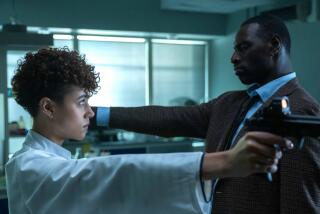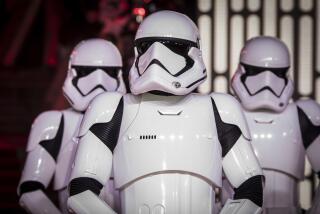From the Archives: The stars return for a new ‘Trek’
- Share via
“Star Trek II: The Wrath of Khan” (citywide Friday) once again propels us into the 23rd Century, but the ride is much smoother than it was in “Star Trek — The Motion Picture.”
In this new film there’s no feeling that its makers are straining to compete with “Star Wars” and other special-effects spectaculars, instead, they’re attempting to recapture the spirit of the beloved TV series. (It is, in fact, probably a plus that the film actually began production intended for TV.) The result is a brisk, handsomely designed film in which its hardware, sturdy as it is, never overwhelms its humanity.
However, “Star Trek II” is not likely to attract many new fans — it requires too much familiarity with the TV series in its nomenclature and its characterizations for that, and is also not enough of a knockout razzler-dazzler. But the Trekkies, of whom there is scarcely a dearth, ought to be ecstatic. Better that it be true to its origins than try to be all things to all people, as did its disappointing big-screen predecessor.
Paul Winfield and Walter Koenig are scouting for a dead planet as a site for a life-generating experiment when they come across a long-banished nemesis of the stalwart Admiral Kirk (William Shatner) of the Starship USS Enterprise. Called Khan (Ricardo Montalban), he is described disdainfully as “a product of the late 20th Century genetic engineering.”
Kirk had come to the rescue of Khan and his people — this happened on the tube way back in 1967 — only to have Khan try to steal the Enterprise and murder Kirk. What if the cunning megalomaniacal Khan, consumed with 15 years’ thirst for revenge, latched on to Project Genesis, as the current trip is called?
Writers Jack B. Sowards and Harve Bennett (the film’s executive producer) shrewdly shift the emphasis away from answering that question to concentrate on how the threat of Khan shakes Kirk out of middle-age malaise and allows him to feel young again.
But first Kirk has to confront himself and realize he’s never come to terms with his own mortality. “Star Trek II” evokes a spiritual sense of the eternal cycle of life and death and rebirth.
Appropriately, the “Star Trek” regulars, headed by Shatner and Leonard Nimoy as the pointy-eared, half-human, half-Vulcan and wholly noble Mr. Spock, this time out seem not to be straining to look as young as they once were. Everyone seems more relaxed, healthier-looking — and therefore more genuinely youthful.
Much of the credit for the film’s spirit must go to director Nicholas Meyer, whose sophisticated affinity for fantasy was well demonstrated in “Time After Time.” Meyer has understood the necessity of pre-serving “Star Trek’s” essential squareness, while regarding it with an affection that saves it from stodginess. He evidently views “Star Trek” as a phenomenon of the turbulent ‘60s that offered a reassuring vision of a future in which good inevitably triumphs over evil.
Meyer keeps intact the obviousness of TV-series acting, especially in the case of Shatner’s often pompous Kirk, but makes it work because of his clear respect for both the actors and the characters they play. Although stuck with a long, silvery wig and plunging neckline that makes him look like a man in drag, Montalban is a fine hiss-inspiring, old-school villain.
More big-screen installments of “Star Trek” are in the offing, and will be welcome if they are as effective as this “Wrath of Khan” (rated PG for some violence) in acknowledging that time doesn’t stand still for actors or characters. The sequels could even be more successful than this film if they resolve the challenge of preserving the unique “Star Trek” quality while becoming more accessible and, therefore, easier to follow for non-Trekkies.
More to Read
Only good movies
Get the Indie Focus newsletter, Mark Olsen's weekly guide to the world of cinema.
You may occasionally receive promotional content from the Los Angeles Times.










